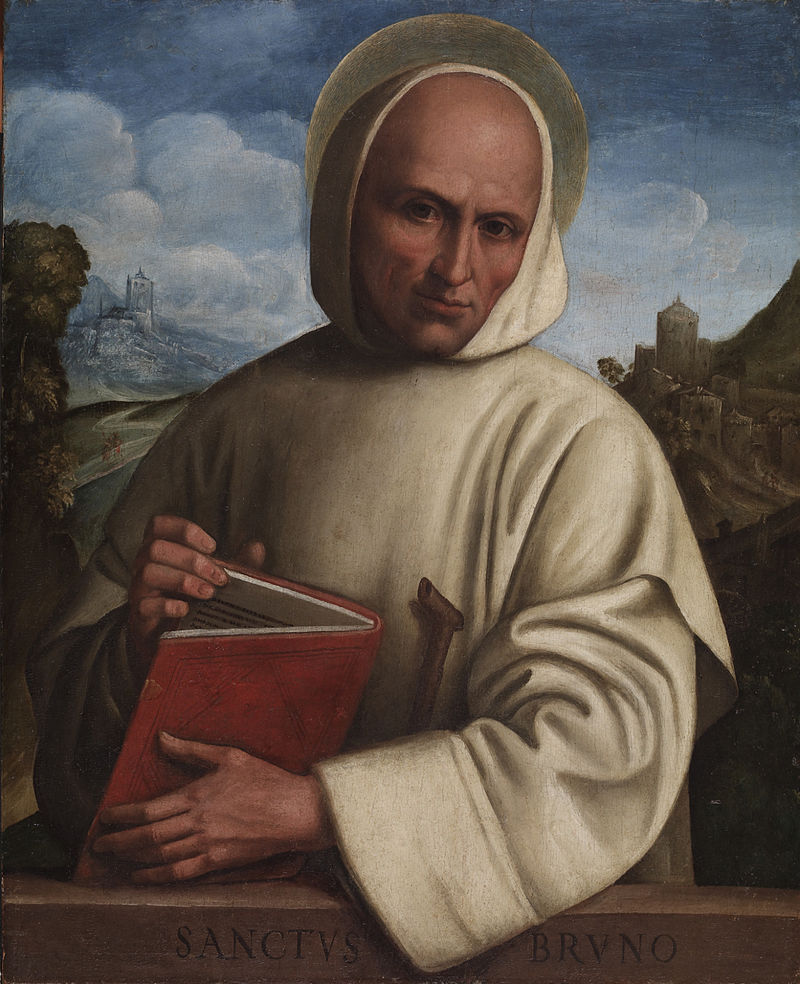Text from The Saint Andrew Daily Missal,
unless otherwise stated.
Saint Bruno.
Confessor.
Feast Day 6 October.
Double.
White Vestments.

Saint Bruno.
Artist: Girolamo Marchesi.
Date: Circa 1525.
Current location: Walters Art Museum,
Baltimore, Maryland,
United States of America.
Credit line: Acquired by Henry Walters with the Massarenti Collection, 1902.
Source: Walters Art Museum.
(Wikimedia Commons)
Saint Bruno was born at Cologne, Germany, in the 11th-Century. With six of his friends, he retired to one of the desert heights of Dauphiny, France, called "Chartreuse", which had been conceded to them by the Bishop of Grenoble (Gospel).
There, he Founded the first Monastery of The Order of Carthusians, which is held in so high esteem by The Church that, by the prescriptions of Canon Law, the Religious of any other Order may enter it so as to lead a more perfect life. [The Order of Carthusians has given to The Church several Saints, two Cardinals, seventy Archbishops and Bishops, and several famous writers, one of the most distinguished being Dionysius the Carthusian.]
Saint Bruno died, pressing The Crucifix to his lips, on 6 October 1101.
Mass: Os justi.

English: Saint Bruno refuses the Archbishopric of Reggio di Calabria.
Español: San Bruno renuncia ante el papa Urbano II al arzobispado de Reggio Calabria.
Date: 4 November 2011.
Current location: Prado Museum, Madrid, Spain.
Author: Vicente Carducho (1576-1638)
(Wikimedia Commons)
The following Text is from Wikipedia - the free encyclopaedia.
On the verge of being made Bishop, Bruno instead followed a Vow he had made to renounce Secular Concerns and withdrew, along with two of his friends, Raoul and Fulcius, also Canons of Reims.
Bruno's first thought on leaving Reims seems to have been to place himself and his companions under the direction of an eminent Solitary, Saint Robert, who had recently (1075) settled at Sèche-Fontaine, near Molesme in the Diocese of Langres, France, together with a band of other Hermits, who were later on (in 1098) to form The Cistercian Order.
But he soon found that this was not his Vocation. After a short stay, he went with six of his companions to Saint Hugh of Châteauneuf, Bishop of Grenoble. The Bishop, according to the pious legend, had recently had a vision of these men, under a Chaplet of Seven Stars, and he installed them in 1084 in a mountainous and uninhabited spot in the Lower Alps of the Dauphiné, France, in a place named Chartreuse, not far from Grenoble. With Saint Bruno, were Landuin, Stephen of Bourg, and Stephen of Die, Canons of Saint Rufus, and Hugh the Chaplain, and two Laymen, Andrew and Guerin, who afterwards became the first Lay Brothers.
They built a an Oratory, with small individual Cells, at a distance from each other, where they lived isolated and in poverty, entirely occupied in Prayer and Study; for these men had a reputation for Learning, and were frequently honoured by the visits of Saint Hugh, who became like one of themselves.

THE SAINT ANDREW DAILY MISSAL



They built a an Oratory, with small individual Cells, at a distance from each other, where they lived isolated and in poverty, entirely occupied in Prayer and Study; for these men had a reputation for Learning, and were frequently honoured by the visits of Saint Hugh, who became like one of themselves.

THE SAINT ANDREW DAILY MISSAL
THE SAINT ANDREW DAILY MISSAL
Available (in U.K.) from
Available (in U.S.A.) from

No comments:
Post a Comment